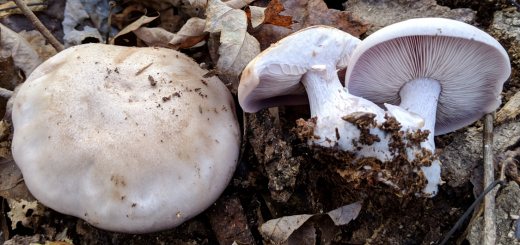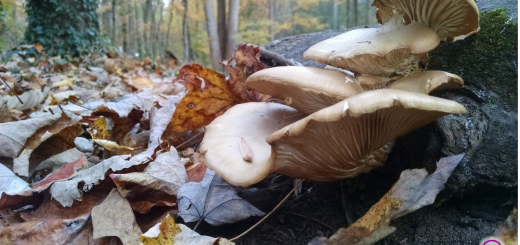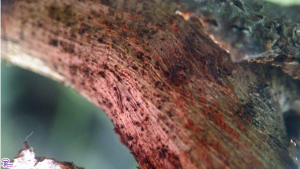#137: Sarcoscypha dudleyi, S. austriaca, and S. coccinea, the Scarlet Cups
These medium-sized cup fungi are bright red, making them easy to spot against the brown colors of the forest floor. Sarcoscypha dudleyi, austriaca, and S. coccinea are all found in the spring during morel season, so make sure to check for morels when you find a Scarlet Cup! These three species are indistinguishable from one another to the naked eye. In order to definitively identify your mushroom, you will have to use a microscope.
The best part about these mushrooms is their bright red color. After a long and mostly mushroom-less winter, Scarlet Cups are a welcome sight (partially because they help herald in the morel season). Unlike many other early cup fungi, they are very easy to spot. The mushrooms are 2-7cm (about 1-3in) in diameter and are cup-shaped. This means that the mushrooms are generally circular with a flat center and upturned edges. However, they may be flatter (disc-shaped), folded, lobed, or otherwise irregular. Scarlet Cups tend to become less regular as they age. The upper surface is bright red and smooth, though older specimens may fade and develop wrinkles near the center. On the underside, the mushroom is whithish to pinkish or orangish and is covered in a thin layer of fuzzy, white hairs. The mushrooms are attached to the ground at the center, sometimes by a rudimentary stipe.
Both species are saprobic and decay woody debris (twigs, sticks, logs, and the like). The mushrooms often appear terrestrial, however, since the wood is frequently buried. S. dudleyi, S. austriaca, and S. coccinea appear in the spring, though S. coccinea can also be found during the winter. The first two (S. dudleyi and S. austriaca) are common and widespread in North America east of the Rocky Mountains. S. austriaca (whose species name means “from Austria”) can also be found in Europe, where it is called the “Scarlet Elfcup.” S. coccinea, on the other hand, grows on the West Coast of North America and in Europe (where it is called the “Ruby Elfcup”). DNA evidence has yet to weigh in on whether or not the North American and European Scarlet Cups belong to the same species.
To identify your Scarlet Cup down to species, you will have to examine it under a microscope. The key features to examine when identifying a Scarlet Cup are the spores and the hairs on the undersurface. S. dudleyi has ellipsoid spores that usually contain two large oil droplets and are fully surrounded by a sheath of mucous-like material. Hairs found on S. dudleyi are straight or slightly curved and are not tangled together. S. austriaca has ellipsoid spores that have neither large oil droplets nor a complete sheath (though some may have a small, partial sheath at each end). Hairs from the undersurface of S. austriaca are highly twisted and intricately intertwined with one another. Finally, S. coccinea produces ellipsoid spores with neither large oil droplets nor a complete or regular sheath. Its hairs are straight or somewhat curved and do not intertwine.
Red is an uncommon color for cup fungi, so these mushrooms are unlikely to be confused with anything else. A similar mushroom from the same genus is S. occidentalis, the “Stalked Scarlet Cup.” It appears later in the year, is rarely larger than 2cm (about 1in), and has a well-defined but small stipe.
The genus Sarcoscypha belongs to the phylum Ascomycota, class Pezizomycetes, order Pezizales, and family Sarcoscyphaceae. Other members of this family are saprobic and form smallish cups, which usually sport red or other bright colors. The order Pezizales includes most mushroom-forming ascomycetes (morels, false morels, cups, etc.). Like other cup fungi, fresh Scarlet Cups will emit a puff of spores if you blow over the surface.
Most field guides list the Scarlet Cups as inedible. Some people eat these mushrooms, but they must be well-cooked. Their relatively small size and bland taste make them undesirable as edibles. Additionally, some authors suspect Scarlet Cups to be slightly poisonous. Therefore, it is generally recommended that you avoid eating these mushrooms.
See Further:
http://www.mushroomexpert.com/sarcoscypha_dudleyi.html
http://www.mushroomexpert.com/sarcoscypha_austriaca.html
http://www.mushroomexpert.com/sarcoscypha_coccinea.html
http://www.first-nature.com/fungi/sarcoscypha-austriaca.php
http://www.first-nature.com/fungi/sarcoscypha-coccinea.php
http://www.mykoweb.com/CAF/species/Sarcoscypha_coccinea.html
http://botit.botany.wisc.edu/toms_fungi/apr98.html









![#011: Characteristics of Kingdom Fungi [Archived]](https://www.fungusfactfriday.com/wp-content/themes/hueman/assets/front/img/thumb-small-empty.png)


2 Responses
[…] of the easiest mushrooms to find this time of year (the start of morel season—get excited!) is Sarcoscypha austriaca. Its bright red colors make it stand out from the brown forest litter. Another commonly […]
[…] than A. aurantia.1 Other vaguely similar mushrooms are the Scarlet Cup Fungi (Sarcoscypha spp., FFF#137). Those fungi are bright red, so you can easily distinguish them from the Orange Peel […]